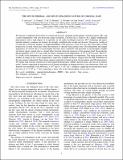Files in this item
The multi-thermal and multi-stranded nature of coronal rain
Item metadata
| dc.contributor.author | Antolin, P. | |
| dc.contributor.author | Vissers, G. | |
| dc.contributor.author | Pereira, T. M. D. | |
| dc.contributor.author | Rouppe van der Voort, L. | |
| dc.contributor.author | Scullion, E. | |
| dc.date.accessioned | 2017-02-14T11:30:11Z | |
| dc.date.available | 2017-02-14T11:30:11Z | |
| dc.date.issued | 2015-06-09 | |
| dc.identifier | 248969440 | |
| dc.identifier | 8f764c31-f9aa-4340-8935-5a2cf2cf0506 | |
| dc.identifier | 84934960659 | |
| dc.identifier.citation | Antolin , P , Vissers , G , Pereira , T M D , Rouppe van der Voort , L & Scullion , E 2015 , ' The multi-thermal and multi-stranded nature of coronal rain ' , Astrophysical Journal , vol. 806 , 81 . https://doi.org/10.1088/0004-637X/806/1/81 | en |
| dc.identifier.issn | 0004-637X | |
| dc.identifier.other | BibCode: 2015ApJ...806...81A | |
| dc.identifier.uri | https://hdl.handle.net/10023/10290 | |
| dc.description.abstract | We analyze coordinated observations of coronal rain in loops, spanning chromospheric, transition region (TR), and coronal temperatures with sub-arcsecond spatial resolution. Coronal rain is found to be a highly multithermal phenomenon with a high degree of co-spatiality in the multi-wavelength emission. EUV darkening and quasi-periodic intensity variations are found to be strongly correlated with coronal rain showers. Progressive cooling of coronal rain is observed, leading to a height dependence of the emission. A fast-slow two-step catastrophic cooling progression is found, which may reflect the transition to optically thick plasma states. The intermittent and clumpy appearance of coronal rain at coronal heights becomes more continuous and persistent at chromospheric heights just before impact, mainly due to a funnel effect from the observed expansion of the magnetic field. Strong density inhomogeneities of 0.″2-0.″5 are found, in which a transition from temperatures of 105 to 104 K occurs. The 0.″2-0.″8 width of the distribution of coronal rain is found to be independent of temperature. The sharp increase in the number of clumps at the coolest temperatures, especially at higher resolution, suggests that the bulk distribution of the rain remains undetected. Rain clumps appear organized in strands in both chromospheric and TR temperatures. We further find structure reminiscent of the magnetohydrodynamic (MHD) thermal mode (also known as entropy mode), thereby suggesting an important role of thermal instability in shaping the basic loop substructure. Rain core densities are estimated to vary between 2 × 1010 and 2.5 × 1011cm−3, leading to significant downward mass fluxes per loop of 1–5 × 109 g s−1, thus suggesting a major role in the chromosphere-corona mass cycle. | |
| dc.format.extent | 21 | |
| dc.format.extent | 2757396 | |
| dc.language.iso | eng | |
| dc.relation.ispartof | Astrophysical Journal | en |
| dc.subject | Instabilities | en |
| dc.subject | Magnetohydrodynamics: MHD | en |
| dc.subject | Sun: activity | en |
| dc.subject | Sun: corona | en |
| dc.subject | Sun: filaments | en |
| dc.subject | Prominences | en |
| dc.subject | Waves | en |
| dc.subject | QB Astronomy | en |
| dc.subject | QC Physics | en |
| dc.subject | NDAS | en |
| dc.subject.lcc | QB | en |
| dc.subject.lcc | QC | en |
| dc.title | The multi-thermal and multi-stranded nature of coronal rain | en |
| dc.type | Journal article | en |
| dc.contributor.institution | University of St Andrews. Applied Mathematics | en |
| dc.identifier.doi | 10.1088/0004-637X/806/1/81 | |
| dc.description.status | Peer reviewed | en |
| dc.identifier.url | http://adsabs.harvard.edu/abs/2015ApJ...806...81A | en |
This item appears in the following Collection(s)
Items in the St Andrews Research Repository are protected by copyright, with all rights reserved, unless otherwise indicated.

